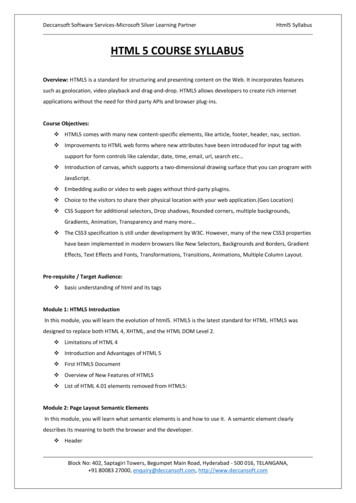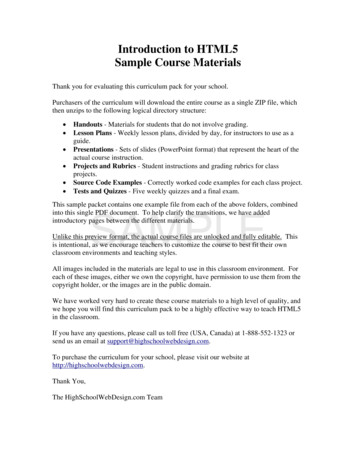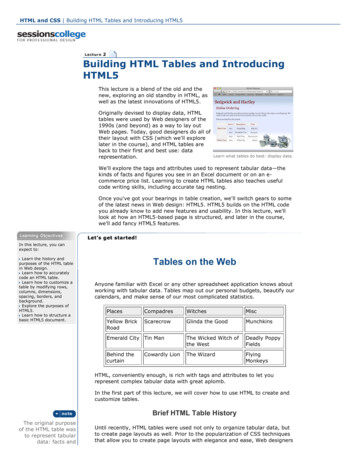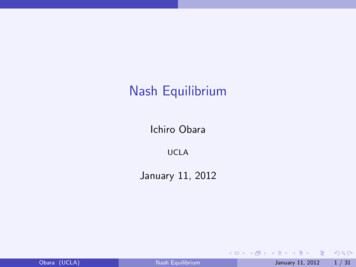
Transcription
Building an HTML5 Video Player withCustom ControlsA Harbinger Group White Paper
Harbinger GroupInnovate.Partner.ExcelAbout Harbinger Group: Harbinger Group (www.harbingergroup.com) is aglobal provider of software products and services since 1990. The HarbingerGroup companies include Harbinger Systems, Harbinger Knowledge Productsand Harbinger Interactive Learning. Harbinger’s patented technology and soundthought leadership have resulted in revolutionary products, including themarket - leading Raptivity . We are a highly applauded and awarded Group ofCompanies. At Harbinger we thrive on innovation, partnership and excellence.Transparency, trust and respect for the individual are the hallmarks of ourculture. Our core values remain ‘Innovate, Partner and Excel’. The Harbingerphilosophy is to create value for its clients through a culture of continuouslearning.This white paper is part of Harbinger’s Web Application practice. Harbinger hasdeep expertise in building consumer internet applications using various cuttingedge technologies in web and desktop. We bring years of experience indeveloping web and connected desktop applications that utilize the latest andmost stable technologies in software development.Contents- Introduction- HTML5 video player- Packaged HTML5 video players- Integration with other video platforms- Mobile challenges- Glossary14781012A Harbinger Systems White Paper Harbinger Group www.harbingergroup.com
IntroductionThe presence of video playback option on a web page is a common case and this can be achievedthrough plugins like Flash Player, Quicktime and SliverLight, etc. However, HTML5 Video Player avoidsthe use of any external plugin for video playback and opens the door to create multiple interactionsbetween video and other elements within the page that has not been possible earlier. HTML5 is thebase for web applications having multiple capabilities which include - Cascading Style Sheets andJavaScript. It is slowly but surely taking over online video space and the market data fromStatCounter, a web analytics firm indicates that all the popular browsers as of today widely supportHTML5 video specification.HTML5 video player is technically a component built into HTML5 browsers. As of now, the keyconcern was the split support for video codecs, but now all modern browsers support the H.264standard. However, the look and feel of the video controls is not consistent across all the browsers.The snapshot below certifies this point since we can see the same webpage in IE, Chrome and Firefoxhaving same options but a different UI.Fig 1: Inconsistency of video controls in HTML5 across browsersA HarbingerSystems White Paper Harbinger Group www.harbingergroup.com1
This consistency can be achieved through an HTML5 player with JavaScript library which will controlthe look and feel of the video controls across all the browsers and provide access to all the video APIsas well.How it works:The HTML5 video tag contains two key attributes, ‘src’ and ‘controls’. The ‘src’ attribute holds theURL which points to the video which is hosted on the web. Therefore, the control features decidesthe visibility/appearance of the on-board/default video player controls. In this, the source of thevideo tag which is present holds the URL - http://clips.vorwaerts-gmbh.de/big buck bunny.mp4’The video tag supports three video formats which include - MP4, OGG and WebM. Out of these tags,MP4 is the most widely supported format by all modern HTML5 browsers. MP4: MPEG 4 files with H264 video codec and AAC audio codec Ogg: Ogg files with Theora video codec and Vorbis audio codec WebM: WebM files with VP8 video codec and Vorbis audio codecIn order to support different formats in the video tag, we just need to remove the ‘src’ attribute ofthe video tag and replace it with the ‘type’ attribute of the individual source tags.The ‘controls’ attribute handles the visibility of the default video controls of the browser. If thisattribute is omitted, then default video controls of the browser will not be visible.Apart from the above key attributes, HTML5 video tag supports various other attributes and eachfeature offers different capabilities. For example, the ‘poster’ attribute allows specifying an image tobe shown until the user plays the video. The ‘autoplay’ attribute allows playing of video as soon as itis ready without any user action.A Harbinger Systems White Paper Harbinger Group www.harbingergroup.com2
The following table lists down which browser version supports the different attributes of HTML5video tag:PosterControlsPreloadAutoplayLoopMutedFirefox Version20 20 20 25 25 25 Chrome Version30 30 20 30 30 30 InternetExplorerVersionSafari Version10 9 10 9 9 9 3 3 5 3 3 3 InternetExplorerVersionSafari Version7.5 7.5 7.5 8.18.18.13 3 3 ---Stock BrowserVersion2.3 4.0 4.0 ---Chrome Version30 30 30 ---Firefox Version20 32 20 32 32 32 oster and Preload attributes behavior in Internet Explorer 9: The poster shows only when preload is set to none Always pre-fetches the entire video, regardless of the preloadsettingA Harbinger Systems White Paper Harbinger Group www.harbingergroup.com3
HTML5 Video PlayerIn this section, we will explain how HTML5 player with custom controls can be created with thefollowing set of features: Play and Pause Control Video Seek bar Volume Control Fullscreen ControlFurther, we will describe how a HTML5 player can be extended to play videos from YouTube, Vimeoand Kaltura platforms.The custom HTML5 player consists of three layers which include: Player Layout – This layer consists of a HTML structure for the Player including necessary playercontrols. It offers overall control on the look and feel of the Player with the help of style sheetand consumes JavaScript APIs exposed by the Player Core Player Core – This is the core layer of the Player consisting of JavaScript APIs. This layer exposesJavaScript APIs for different video elements like play, pause, volume, total video duration,current video time, etc. This layer internally consumes different wrapper APIs based on the typeof video Video Delivery Platforms – The video source file hosted on CDN platforms are streamed directlyfrom the respective CDN platform by this layerA Harbinger Systems White Paper Harbinger Group www.harbingergroup.com4
Fig 2: Architecture of HTML5 video playerHaving seen the high level architecture, we will now elaborate on how custom control functionalitycan be implemented within the video player.Play and Pause Control: A common method can be created to toggle the video. This method caninternally detect the current state of the video based on which it either plays or pauses the video.Video Seek bar: The JQuery UI range slider can be used for implementing a video seek bar. For thethe range slider, we need to provide the total duration of the video as the maximum parameter.A Harbinger Systems White Paper Harbinger Group www.harbingergroup.com5
Volume Control: A common method can be created to set and retrieve the volume. If the volumeparameter is passed then it sets the volume or else the method returns to the current volume. Thevolume parameter scale range can be decided as per the requirements, usually, its generic range isfrom 0 to 1.Fullscreen Control: The HTML5 Fullscreen API can be used to implement this feature. A commonmethod is used to toggle the video fullscreen, this method internally detects the current state of thevideo fullscreen based on which it either enters the video into fullscreen mode or exits the video fromfullscreen mode.These custom controls ensure the look and feel of the player control to remain consistent across allthe browsers, as seen in the screen snapshot below. (Reference: link http://clips.vorwaerts- gmbh.de/big buck bunny.mp4 )Fig 3: Consistent controls in HTML5 video playerThings to rememberFollowing are some of the few generic guidelines which ensure player size and custom controlsremains intact in all scenarios: The z-index for html elements of the custom player controls has to be set to 2147483647. Thiswill keep the custom player controls visible when the video is in fullscreen mode If the video is embedded using HTML5 video tag then the following style sheet needs to be addedto hide the browser native video controls in the fullscreen modevideo::-webkit-media-controls {display:none !important;A HarbingerSystems White Paper} Harbinger Group www.harbingergroup.com6
The viewport meta tag needs to be added in the player HTML to keep the player in its original size inthe mobile devices metaname "viewport"content "width device-width,height device-height,initial-scale 1.0" Packaged HTML5 video playersThere are many app developers in the industry who readily offer HTML5 video players. The followingTable lists down some of the well-known HTML5 video players and compares them on differentParameters: (reference: http://praegnanz.de/html5video/)Attributes lscreenKeyboardInterfaceSubtitlesSupportStandalone - - PlayersVideo JSGPL v3JW PlayerCustomFlow PlayerFreeversionGPL v3GPL v3JQuery JQuery GPLv2and MITGPLv2and MITService(FreeOption)GPL v3JQuery - JQuery - Standalone Standalone- LeanBackA Harbinger Systems White Paper Harbinger Group www.harbingergroup.com7
Integration with other video platformsIn this section, we will explain how to extend the capabilities of a custom video player to enable it forplaying the videos hosted across different video delivery platforms. There are many video deliveryplatforms available but we will cover the most popular ones in this whitepaper.YouTubeYouTube provides IFrame Player API using which YouTube videos can be embedded. This API providesseamless interface with YouTube player and also offers the ability to control YouTube video events,properties and methods.The HTML5 video player needs to implement ‘onYouTubeIframeAPIReady’ JavaScript function. TheIframe API invokes this function once the JavaScript for player API is loaded. Internally, this methodcan initialize the YouTube player object using YouTube video ID which would load the video.The API offers ‘onReady’ and ‘onStateChange’ events. The ‘onReady’ event gets triggered when thevideo player is ready to play the video and ‘onStateChange’ event gets triggered when the playerstates the changes, which indicate that the player is playing, paused, finished and so forth. /youtube/iframe api referenceVimeoVimeo provides JavaScript Player API which gives the ability to control the embedded Vimeo player.The API offers a window.postMessage() mechanism to interact with the player and the same can beachieved by sending a serialized JSON object with postMessage(). The format of the JSON object is asfollows:{"method": "methodName","value": "value"A HarbingerSystems White Paper} Harbinger Group www.harbingergroup.com8
If a method does not accept the value then we need to omit the value key. As the postMessage()mechanism is complex, Vimeo offers a JavaScript mini library called Froogaloop that acts as awrapper over the postMessage() and makes life easier for the developer. The library reference canbe added as follows: script src "https://f.vimeocdn.com/js/froogaloop2.min.js" /script The API also offers ‘loadProgress’ and ‘playProgress’ events. In this functioning, ‘loadProgress’ eventgets triggered when the video is loading; it shows the current loaded percentage and the duration ofthe video. The ‘playProgress’ event gets activated when the video is playing; it shows the seconds,percentage exhausted and the total duration of the video. The detailed information about JavaScriptAPI is available on Vimeo developer portal. https://developer.vimeo.com/player/js-apiPlease note, the Vimeo API does not provide the mechanism tooverride or hide the default Vimeo video player controls. Thedefault Vimeo video player controls can be controlled by the ownerof the video from the Vimeo portal. This feature is available for theusers of Vimeo Plus or Pro account.KalturaKaltura provides a kWidget API using which a standalone video URL can be retrieved for the videoshosted in Kaltura. The video URL then can be used as a source in the standard HTML5 video tag toembed the video. The kWidget API returns multiple video URLs having different sizes and bitrates.The kWidget API is available after we include it in the Kaltura player API library. JavaScript way ofincluding Kaltura Player API library is as follows: !-- Substitute {partner id} for your Kaltura partner id, {uiconf id} for uiconf player id -- scriptsrc "http://cdnapi.kaltura.com/p/{partner id}/sp/{partnerId}00/embedIframeJs/uiconf id/{uiconf id}/partner id/{partnerId}" /script A Harbinger Systems White Paper Harbinger Group www.harbingergroup.com9
The ‘getSources’ method of kWidget API accepts partnerId and entryId as input parameters andfires a callback method which can capture the video sources information. The ‘mediaReady’event of the API gets triggered when the player is ready to play the video. The h api Similarly, the other video delivery platforms can be integrated seamlessly with the customvideo player, just by plugging the necessary APIs offered by the video platforms.Mobile ChallengesToday, most of the mobile browsers are developed having HTML5 compatibility. HTML5 hasupgraded and advanced in the sector of Animation and Video but there is a huge scope ofimprovement for mobile based browsers. However, recently developed mobile browsers do haveadequate support for HTML5 video tag specifications. Also, the screen size and network bandwidth ofa mobile device is small and limited when compared with desktop computers. These two factorshighlight the limitations on some of the attributes of the HTML5 video tag as listed below: Autoplay or preload is not supported on mobile devices. This means on mobile devices videowill not start playing or buffering till the time the user performs some action. Volume property of video is read-only on mobile devices. This means on mobile devices the userwill not be able to control video volume using custom controls. The video volume will becontrolled by the user using device volume control. HTML5 Fullscreen – iOS Safari browser and Android Stock browser does not support HTML5Fullscreen APIs iPhone does not play video inline in the webpage, it plays the video in fullscreen mode usingnative video controls. Therefore, the custom video player controls will not be visible on theiPhone screen. Apple provides webkit-playsinline attribute for video tag to play video inline inwebpage, however, as observed by us, this attribute works only when the webpage isbookmarked to iPhone home screen. The native video player application with custom controlscan be built for the iPhone with the help of MPMoviePlayerController class reference.A Harbinger Systems White Paper Harbinger Group www.harbingergroup.com10
As we move ahead with the continuous evolvement of HTML5 video tag specification we canexperience that the player with HTML5 capabilities is emerging to be as a widely used standardizedcommon for delivering exceptional videos across browsers and devices. The three layeredarchitecture ensures new controls can be easily programmed in the custom HTML5 video player. Italso provides scalability to include other available delivery platforms.Contact us now, to know more about our services in the HTML5 video player space.A Harbinger Systems White Paper Harbinger Group www.harbingergroup.com11
Glossary AAC: Advanced Audio Coding (AAC) is an audio coding standard for lossy digital audiocompression CDN: A content delivery network or content distribution network (CDN) is a large distributedsystem of servers deployed in multiple data centers across the Internet Froogaloop: Small JavaScript utility framework to help with the complexities involved in dealingwith using the JavaScript API through window.postMessage for controlling Vimeo's Moogaloopvideo player GPL: The GNU General Public License (GNU GPL or GPL) is the most widely used free softwarelicense, which guarantees end users (individuals, organizations, companies) the freedoms torun, study, share (copy), and modify the software H.264: Advanced Video Coding (MPEG-4 AVC) is a video coding format that is currently one ofthe most commonly used formats for the recording, compression, and distribution of videocontent JSON: JavaScript Object Notation is a lightweight data-interchange format. It is easy for humansto read and write. It is easy for machines to parse and generate. kWidget: HTML5 Kaltura JavaScript API library MP4: Digital multimedia format most commonly used to store video and audio, but can also beused to store other data such as subtitles and still images MPMoviePlayerController: A movie player manages the playback of a movie from a file or anetwork stream OGG: Free, open container format maintained by the Xiph.Org Foundation. The creators of theOgg format state that it is unrestricted by software patents and is designed to provide forefficient streaming and manipulation of high quality digital multimedia. VP8: Video compression format owned by Google and created by On2 Technologies as asuccessor to VP7 WebM: Video file format, primarily intended to offer a royalty-free alternative to use in theHTML5 video tag. The development of the format is sponsored by Google, the correspondingSoftware is distributed under a BSD license.A Harbinger Systems White Paper Harbinger Group www.harbingergroup.com12
HTML5 video specification. HTML5 video player is technically a component built into HTML5 browsers. As of now, the key concern was the split support for video codecs, but now all modern browsers support the H.264 standard. However, the look and feel of the
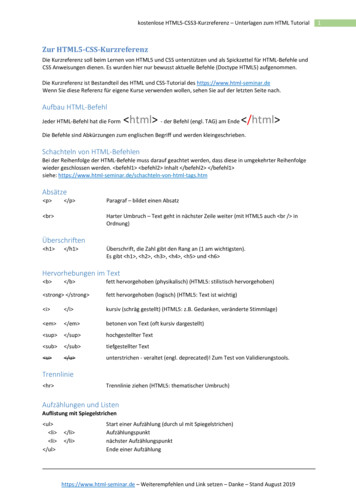
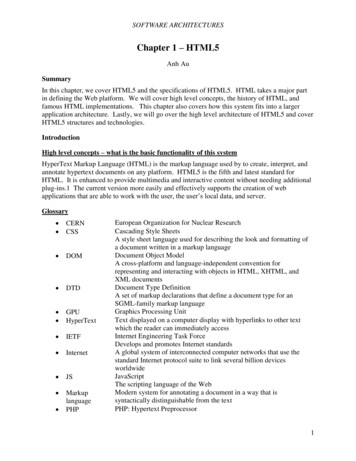

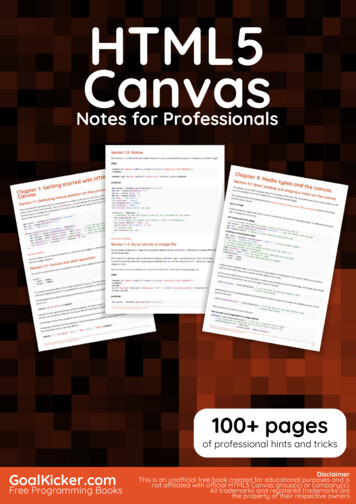
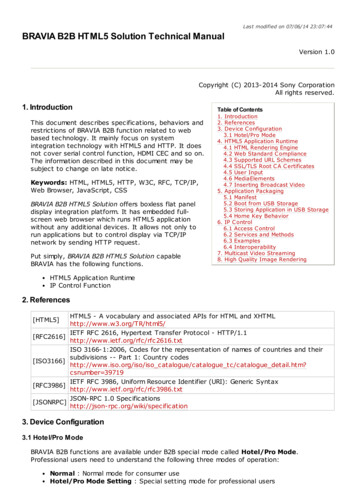
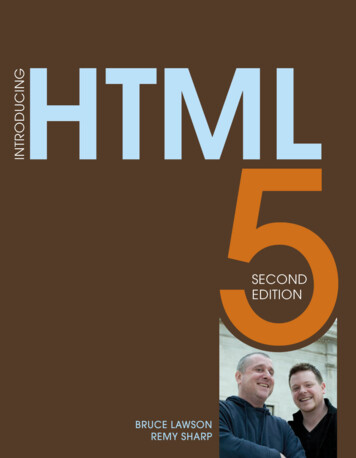
![[MS-HTML5]: Microsoft Edge / Internet Explorer HTML5 .](/img/13/ms-html5-170314.jpg)
